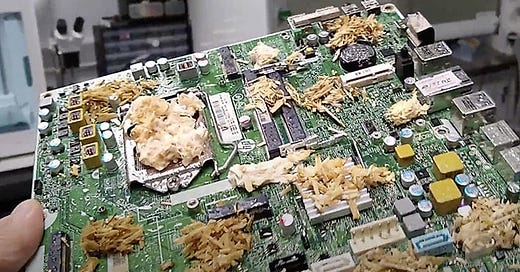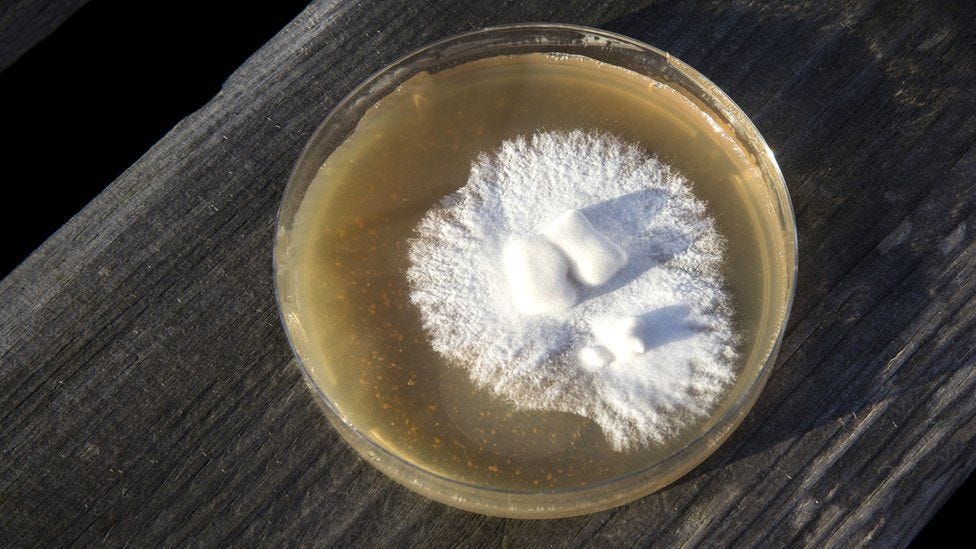From Forest to Circuit Board: Scientists Create Mushrooms-Based Living Motherboard!
Fungi Friday's - March 10, 2023 - Issue #71
Happy Friday, Fungi Fam!
Did you have a good week? We did — can’t believe it’s the weekend once again. But it is, and of course with that, we’re back to bring you all the best when it comes to the fungi focused areas on the inter-webs. And do we have a few fun ones for you today!
In today’s email:
A Living Motherboard Made With Mushrooms
Mushrooms your can Build With
Magic Mushrooms and their Effect on the Brain
Iowa Fungi’s Update of the Week
Day after day, the temperatures keep getting better and better here in the midwest. The snow is thawing, the ground is warming, and we are slowly inching towards that April 1st planned beginning of the 2023 growing season! Placed the first spawn order of our year last weekend, which was confirmed to arrive in the next few weeks. Getting excited, it’s almost here!
What The Fungi? Scientists Create A Living Motherboard Made With Mushrooms
Scientists have created a living "motherboard" made from mushrooms and other organic materials, which they believe could be used to create more sustainable electronic devices. Researchers at the Stevens Institute of Technology in New Jersey used a common edible mushroom, Pleurotus ostreatus, to create a superstructure capable of carrying electricity. They combined the mushroom with other organic materials to make a scaffold that they then infused with the fungus. Once the fungus was mature, the researchers could program it to carry an electrical charge by applying a small amount of voltage. The team said the structure could be used to create environmentally friendly devices, such as a home that can detect carbon monoxide, or to create living materials that could be used in architecture or fashion.
The researchers believe their work could lead to a new field of "fungineering", where fungi are used to create a range of biological machines, and they plan to test the technique with other fungi. However, the technology is still in its early stages, and there are concerns about the stability of the fungal superstructure over time, as well as the potential impact of fungi on human health.
Psychedelic Spotlight
New research examines the potential of microdosed psilocybin, found in "magic mushrooms," for treating neuropathic pain. Click here to read more!
As the conversation around magic mushrooms evolves, some people may be concerned about whether or not these substances are addictive. This article explores the topic and highlights the current research on the addictive potential of psilocybin.
The mushrooms you can wear and build with
Designer and mycologist Sophia Wang is exploring the potential of mycelium, the thread-like network that mushrooms grow from, to create sustainable materials for clothing and construction. Wang is using mycelium to create a fabric-like material that can be used to make clothes and shoes, as well as using it to grow bricks for construction.
Mycelium has several advantages as a material: it is strong and durable, it can be grown quickly, and it is biodegradable, meaning that it can be composted at the end of its life. However, there are also challenges, including the need to find ways to scale up production and to ensure that the materials are cost-effective. Wang believes that mycelium could be a game-changer for sustainable fashion and construction, and she is not alone in her enthusiasm.
Companies such as Bolt Threads, MycoWorks, and Ecovative are also exploring the potential of mycelium-based materials, and there is growing interest in this field from investors and consumers alike.
More Mushroom Mentions
The Science of Psilocybin and Its Effects on the Brain
Psilocybin, the psychedelic compound found in "magic mushrooms," has been found to have a profound effect on the brain, with studies showing that it can alter brain activity and neural connections in ways that are thought to be associated with improved mood and cognitive function. Psilocybin works by binding to serotonin receptors in the brain, leading to changes in brain activity and connectivity that can last for weeks or even months after the drug is taken.
Studies have found that psilocybin can reduce activity in the default mode network, a network of brain regions that is thought to be involved in self-referential thinking and mind-wandering. This reduction in activity is thought to be responsible for the drug's ability to produce a state of "ego dissolution" or a loss of the sense of self.
Psilocybin has also been found to increase connectivity between brain regions that are not normally connected, leading to a "re-wiring" of the brain that may be associated with improvements in mood, creativity, and cognitive function. However, more research is needed to fully understand the mechanisms by which psilocybin produces these effects, and to determine the optimal dosing and conditions for its use as a therapeutic agent.
That’s all, folks… but before we let you go, leave a comment below on how we can make the publication even better! And if you haven’t yet, smash that SUBSCRIBE button below.
Thanks for reading as always,
BowTiedMushroom




